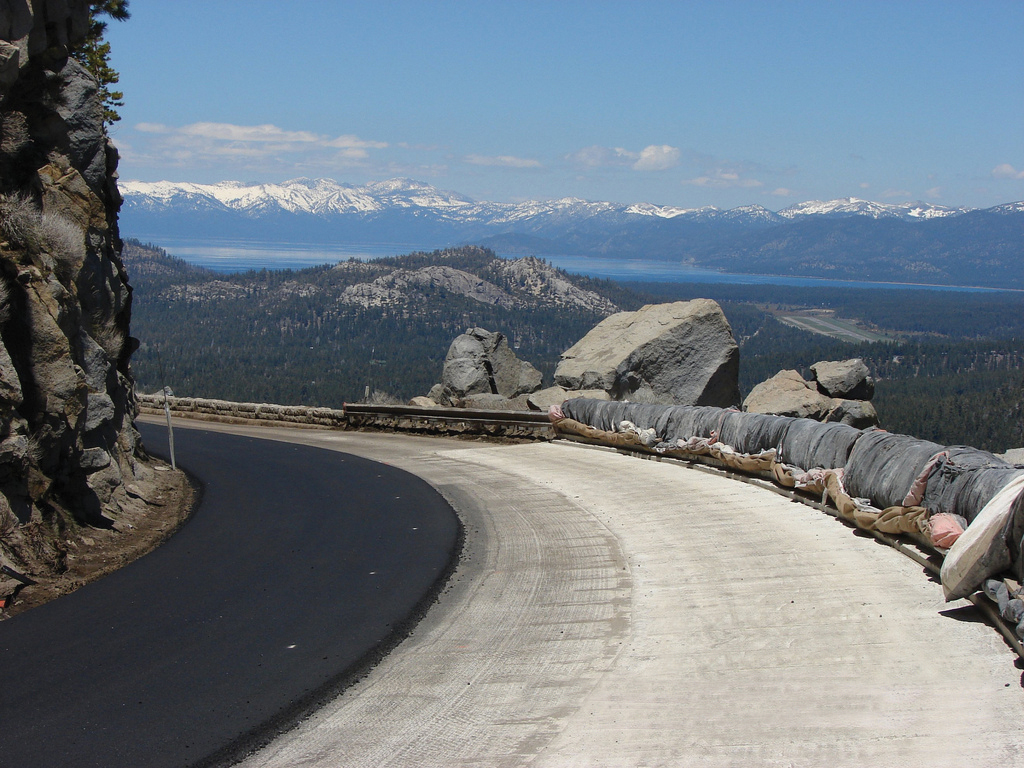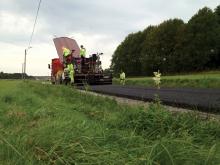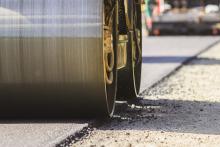Lower temperature mixes – a key advance in bitumen technology - Kristina Smith reports
Warm and cold mix asphalts were not on the original agenda for this year’s Eurasphalt & Eurobitume Congress, being held in Istanbul in June. But when the organisers took a look through the papers submitted for their sustainability-themed event, they realised that this is one of the industry’s hottest topics.
“We hadn’t quite anticipated the high level of research in this area,” says E&E’s technical programme committee c

Evothem supplied its technology for ruse on the US50 link to Lake Tahoe as the route lies at high altitude
RSS
The cost of bitumen, which accounts for around a third of the cost of building a new road, is playing its part in this move from hot towards warm or even cold mixes. In the UK,2399 Tarmac reports that bitumen has increased in price by nearly 60% over the last two years. This is driving Tarmac to look for ways to increase the recycled asphalt content on resurfacing contracts, says the firm.
Nowhere is it more apparent in the rise in popularity of lower temperature mixes than in the US, where warm mix asphalt has taken a serious chunk of the market share from hot mix asphalt. Trials of warm mix began around 2002 in the US but by the end of 2011 accounted for 13%, according to the National Asphalt Paving Alliance (NAPA). Current estimates put that share as high as 20%.
“It’s the sheer economics that the contractors like,” said Heather Dolan, asphalt commercialisation manager for MMV’s specialty chemicals division which produces Evotherm, a warm mix asphalt product. “They save money on any mix tonne they lay down. And they see the savings straight away.”
In the US, warm mix asphalts are classed as those that are produced at 28°C or more below hot mix asphalts, which can require 160-180°C. In Europe, the industry also uses half-warm and cold mixes. Broadly speaking, warm mixes have mix temperatures from 100-140°C; half-warm or semi-warm mixes lie from 65-100°C; and cold mix between 0-30°C.
Warm mix asphalt can be produced using a number of different technologies, or combinations of those technologies. The most popular in the States, and the first technology to come along, are based on foamed asphalt. Others add waxes. Envirotherm 3G, MWV’s latest version of the warm mix technology which it launched in 2007, and other competitors, see chemicals added to the mix.
According to Dolan, while foamed asphalt technologies save around 15% on fuel costs, chemical technologies such as Envirotherm 3G save 30%. The savings on fuel cost alone would not pay for the cost of the additive. But when other cost efficiencies, such as being able to use more RAP and therefore less virgin asphalt, are taken into consideration, warm mix comes out better than hot ones.
New York DoT has switched to warm mix technology for 100% of its paving, as it cuts emissions and meets various environmental targets. In New York, plants run at 40% RAP where they are equipped to do so, according to Dolan. “They have a tremendous amount of recycled material and they don’t want to send it to landfill,” she said.
In California, the Department of Transportation (5246 Caltrans) is keen on crumb rubber in asphalt, important as polymers rise in price but also because it removes tyres, and the associated environmental problems, from landfill. Warm asphalt provides the ideal medium for this because it can accommodate the crumb rubber and because the lower temperatures mean no burning rubber smell when it is used.
Another general benefit of warm mix asphalts is they can be used over extended haul distances and in lower temperatures: the cooler the mix, the slower it loses heat. This means the material allows a longer compaction window, reducing the risk of over-compaction and of crushing stone, as well as reducing problems of under-compaction and early failure of a surface, said Dolan.
For some US states, this extends the paving season. And in other countries this property is being put to good use too.
In Mexico City’s federal district a 100% warm mix is used. While the authorities began using Evotherm because of the reduced emissions while it is being laid, knock-on benefits were soon discovered. Because of the huge volume of traffic which clogs the city each day, all paving takes place at night. And, situated on a plateau at an altitude of 2,240m, night time temperatures are low, making it an ideal environment for warm mixes to shine.
Perhaps most extreme of all, the Chinese Army used Envirotherm 3G for warm mix asphalt trials on what is billed as the world’s highest highway, the G219 linking Xinjiang and Tibet. The 1km section is at an altitude of 3,500m and air temperatures were as low as minus 2°C during construction. MWV reports that China is now considering using the technology on other high altitude roads.
While warm mix is today’s solution for a growing number of countries and clients, some believe that tomorrow’s solution will be cold mix. “Looking at the bigger picture, I see warm mix as a temporary situation,” said Anders Marshall Jensen, CEO and managing director of6446 DenimoTech which makes plants for bitumen emulsion and Polymer Modified Bitumen. “We are on a journey, going from hot mixes to warm mixes and eventually we will end up at cold mixes. It’s all about moving towards cold production methods which can give you the same properties and performance in your roads and in your mixes.”
DenimoTech has supplied two state-of-the-art bitumen emulsion plants to294 Nynas in Sweden recently, to help the company meet current demands and to equip it for future developments. The first machine arrived in Gothenburg in 2009, with a second one starting up in Västerås last year. Both have a capacity of around 30tonnes/hour.
Able to produce all currently known types of emulsion, these plants are also flexible to allow Nynas to develop its emulsion technologies, according to Jenson. With heat recovery which returns waste heat to the beginning of the process and a start-up process which produces no waste material, DenimoTech claims the highest environmental credentials for its kit. The heart of these plants are their colloid mills which control the droplet size distribution which impact on the emulsion’s viscosity and breaking behaviour.
Use of emulsions is well-established in Sweden, mainly used for surface dressing, sealings and cold mixes. According to Jenson, with a well-planned maintenance regime, resurfacing can save two-thirds of the cost when using cold mix compared to hot mix.
Outside Europe, Jensen sees some take-up of cold mix technology in the Middle East, Australia and South Africa. And there is interest in cold mix technology from the BRIC countries and emerging markets such as Indonesia and Vietnam said Jensen, “Countries where there is growth in GDP, where the middle classes are suddenly able to buy cars; that is where they will need roads.”
Jensen believes that some countries could even move straight to cold mix, leapfrogging the intermediate step of warm mix. Post-war zones where infrastructure is desperately required are potential markets, where entrepreneurs from outside the industry are willing to work with non-standard technologies, given the right support.
One of the barriers to the uptake of cold mix in some parts of the developed world is perception, according to Dennis Day, Nynas’ product manager for cold mix in the UK. “Cold mixes do tend to look different to hot mixes when they are made,” said Day. “One of our customers told us that although he has seen that cold mix does work, all the theories are telling him that it should not work. It’s difficult to change that mindset. But I think the tide is turning.”
Cold mix has proved its worth on many country roads around the UK with successful trials in Northamptonshire over five years ago for example which used 100% RAP as a surface course material. But each time a contractor wants to use cold mix with a new local authority, there has to be yet another trial. “There are no standards for emulsion cold mixes in the UK, whereas in France, Lithuania, Sweden and Norway they already have standards in place,” said Day. In France the market for cold mix is around 1 million tonnes/year.
However, there is an increasing interest from local authorities in the UK, said Day. He thinks this is down to government efforts focusing on sustainability and reducing carbon emissions. As well as re-using recycled road material, cold mixes save around 90% of energy in production compared to hot mixes.
The next step for cold mix in the UK would be to see greater use on evolved country roads up B roads and some A roads. Around 90% of all roads in the UK are local authority controlled, but one of the frustrations for Nynas and others is that local authorities sometimes won’t consider materials that aren’t in the national Specification for Highway works.
Cold mix has been used on one major UK trunk road. Day highlighted a trial on the A90 Perth to Dundee road, where an 800m section was rebuilt using cold mix as the base course layer saving 43 tonnes of CO2. It was the first use of emulsion based cold mix on a trunk road, and 3.5 years later it is performing well. And in Lithuania, a 3.4km length of the A1 which is a four lane motorway now has a cold mix base course.
“The world is changing,” said Day. “We are seeing a change from local authority clients who are more open to using these materials.”RSS
Lower temperature mixes – a key advance in bitumen technology - Kristina Smith reports
Warm and cold mix asphalts were not on the original agenda for this year’s Eurasphalt & Eurobitume Congress, being held in Istanbul in June. But when the organisers took a look through the papers submitted for their sustainability-themed event, they realised that this is one of the industry’s hottest topics.
We hadn’t quite anticipated the high level of research in this area,” says E&E’s technical programme committee chair Mike Southern. “While reviewing the papers we had to acknowledge this distinct trend: hence the move to a dedicated session.” So ‘Warm Mix Asphalts and Low Temperature Techniques’ is now a session in its own right (see box).
The cost of bitumen, which accounts for around a third of the cost of building a new road, is playing its part in this move from hot towards warm or even cold mixes. In the UK,
Nowhere is it more apparent in the rise in popularity of lower temperature mixes than in the US, where warm mix asphalt has taken a serious chunk of the market share from hot mix asphalt. Trials of warm mix began around 2002 in the US but by the end of 2011 accounted for 13%, according to the National Asphalt Paving Alliance (NAPA). Current estimates put that share as high as 20%.
“It’s the sheer economics that the contractors like,” said Heather Dolan, asphalt commercialisation manager for MMV’s specialty chemicals division which produces Evotherm, a warm mix asphalt product. “They save money on any mix tonne they lay down. And they see the savings straight away.”
In the US, warm mix asphalts are classed as those that are produced at 28°C or more below hot mix asphalts, which can require 160-180°C. In Europe, the industry also uses half-warm and cold mixes. Broadly speaking, warm mixes have mix temperatures from 100-140°C; half-warm or semi-warm mixes lie from 65-100°C; and cold mix between 0-30°C.
Warm mix asphalt can be produced using a number of different technologies, or combinations of those technologies. The most popular in the States, and the first technology to come along, are based on foamed asphalt. Others add waxes. Envirotherm 3G, MWV’s latest version of the warm mix technology which it launched in 2007, and other competitors, see chemicals added to the mix.
According to Dolan, while foamed asphalt technologies save around 15% on fuel costs, chemical technologies such as Envirotherm 3G save 30%. The savings on fuel cost alone would not pay for the cost of the additive. But when other cost efficiencies, such as being able to use more RAP and therefore less virgin asphalt, are taken into consideration, warm mix comes out better than hot ones.
New York DoT has switched to warm mix technology for 100% of its paving, as it cuts emissions and meets various environmental targets. In New York, plants run at 40% RAP where they are equipped to do so, according to Dolan. “They have a tremendous amount of recycled material and they don’t want to send it to landfill,” she said.
In California, the Department of Transportation (
Another general benefit of warm mix asphalts is they can be used over extended haul distances and in lower temperatures: the cooler the mix, the slower it loses heat. This means the material allows a longer compaction window, reducing the risk of over-compaction and of crushing stone, as well as reducing problems of under-compaction and early failure of a surface, said Dolan.
For some US states, this extends the paving season. And in other countries this property is being put to good use too.
In Mexico City’s federal district a 100% warm mix is used. While the authorities began using Evotherm because of the reduced emissions while it is being laid, knock-on benefits were soon discovered. Because of the huge volume of traffic which clogs the city each day, all paving takes place at night. And, situated on a plateau at an altitude of 2,240m, night time temperatures are low, making it an ideal environment for warm mixes to shine.
Perhaps most extreme of all, the Chinese Army used Envirotherm 3G for warm mix asphalt trials on what is billed as the world’s highest highway, the G219 linking Xinjiang and Tibet. The 1km section is at an altitude of 3,500m and air temperatures were as low as minus 2°C during construction. MWV reports that China is now considering using the technology on other high altitude roads.
While warm mix is today’s solution for a growing number of countries and clients, some believe that tomorrow’s solution will be cold mix. “Looking at the bigger picture, I see warm mix as a temporary situation,” said Anders Marshall Jensen, CEO and managing director of
DenimoTech has supplied two state-of-the-art bitumen emulsion plants to
Able to produce all currently known types of emulsion, these plants are also flexible to allow Nynas to develop its emulsion technologies, according to Jenson. With heat recovery which returns waste heat to the beginning of the process and a start-up process which produces no waste material, DenimoTech claims the highest environmental credentials for its kit. The heart of these plants are their colloid mills which control the droplet size distribution which impact on the emulsion’s viscosity and breaking behaviour.
Use of emulsions is well-established in Sweden, mainly used for surface dressing, sealings and cold mixes. According to Jenson, with a well-planned maintenance regime, resurfacing can save two-thirds of the cost when using cold mix compared to hot mix.
Outside Europe, Jensen sees some take-up of cold mix technology in the Middle East, Australia and South Africa. And there is interest in cold mix technology from the BRIC countries and emerging markets such as Indonesia and Vietnam said Jensen, “Countries where there is growth in GDP, where the middle classes are suddenly able to buy cars; that is where they will need roads.”
Jensen believes that some countries could even move straight to cold mix, leapfrogging the intermediate step of warm mix. Post-war zones where infrastructure is desperately required are potential markets, where entrepreneurs from outside the industry are willing to work with non-standard technologies, given the right support.
One of the barriers to the uptake of cold mix in some parts of the developed world is perception, according to Dennis Day, Nynas’ product manager for cold mix in the UK. “Cold mixes do tend to look different to hot mixes when they are made,” said Day. “One of our customers told us that although he has seen that cold mix does work, all the theories are telling him that it should not work. It’s difficult to change that mindset. But I think the tide is turning.”
Cold mix has proved its worth on many country roads around the UK with successful trials in Northamptonshire over five years ago for example which used 100% RAP as a surface course material. But each time a contractor wants to use cold mix with a new local authority, there has to be yet another trial. “There are no standards for emulsion cold mixes in the UK, whereas in France, Lithuania, Sweden and Norway they already have standards in place,” said Day. In France the market for cold mix is around 1 million tonnes/year.
However, there is an increasing interest from local authorities in the UK, said Day. He thinks this is down to government efforts focusing on sustainability and reducing carbon emissions. As well as re-using recycled road material, cold mixes save around 90% of energy in production compared to hot mixes.
The next step for cold mix in the UK would be to see greater use on evolved country roads up B roads and some A roads. Around 90% of all roads in the UK are local authority controlled, but one of the frustrations for Nynas and others is that local authorities sometimes won’t consider materials that aren’t in the national Specification for Highway works.
Cold mix has been used on one major UK trunk road. Day highlighted a trial on the A90 Perth to Dundee road, where an 800m section was rebuilt using cold mix as the base course layer saving 43 tonnes of CO2. It was the first use of emulsion based cold mix on a trunk road, and 3.5 years later it is performing well. And in Lithuania, a 3.4km length of the A1 which is a four lane motorway now has a cold mix base course.
“The world is changing,” said Day. “We are seeing a change from local authority clients who are more open to using these materials.”RSS








